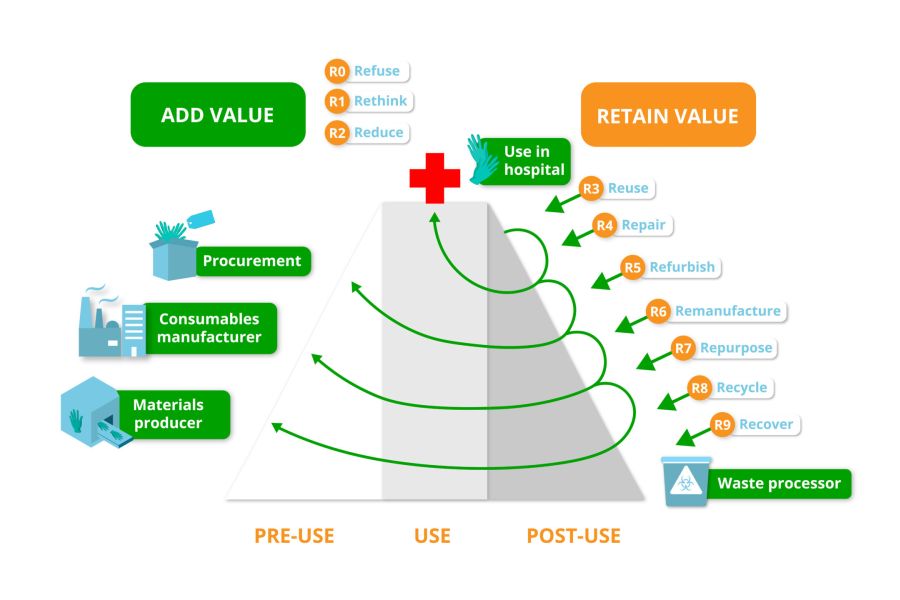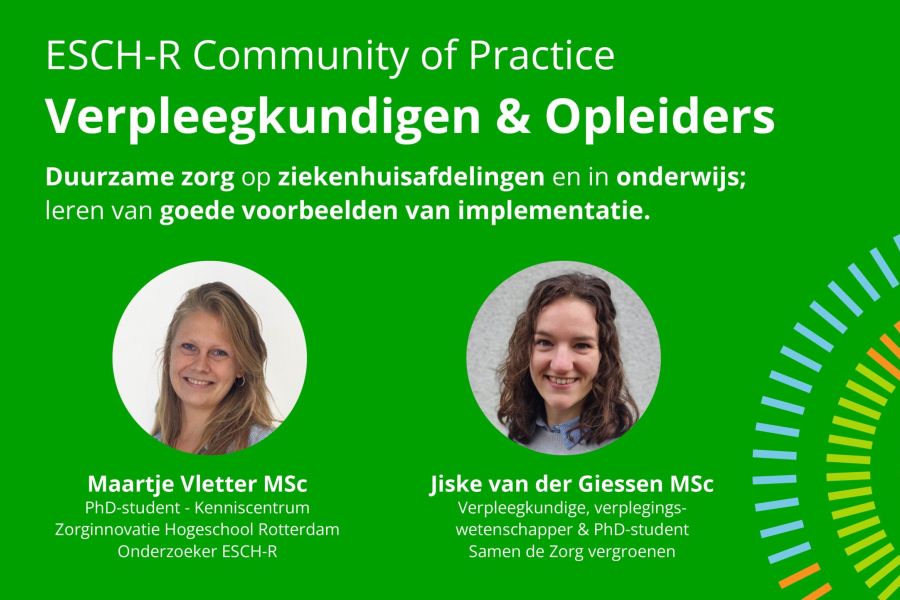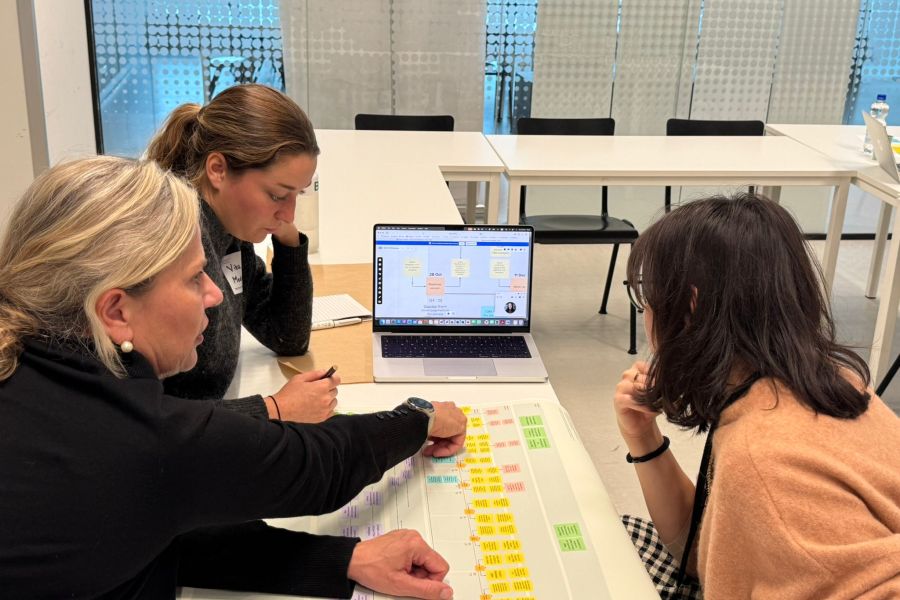Accelerating the transition from a linear to a circular healthcare sector: ESCH-R: study design and methodology

Figure 2.
The 10R-value hill in the context of the ESCH-R project.
Published in: Frontiers Planetary Health

Authors: Jilske Huijben, Erik van Raaij, Albert Wagelmans, Laura Piscicelli, Wei-Shan Chen, Bas van Vliet, Diederik Gommers, Dick Tibboel, Ellen Bakker, Florijn Dekkers, Redmer van Leeuwen, Jan Carel Diehl, Nicole Hunfeld
Due to the significant environmental impact of healthcare, there is an urgent need to accelerate its circular transition. We provide an overview of the ESCH-R project study design and methodology for accelerating the transition from a linear to a circular healthcare sector through the development and implementation of circular interventions in the Netherlands. Using a transdisciplinary approach, we will apply the 10-R ladder framework for a circular economy to hospitals. Methods are presented to analyze current clinical practices, policies and requirements for sustainable behavioral change, from material flows and operations to policy and regulations. We describe methods for the development of circular interventions, including business models, contract templates, and product redesigns. Finally, our approach to dissemination and education is presented. The described study design and methods can be used by other hospital (settings) to identify environmental hotspots for circular interventions in their own healthcare practice and for the cross-transfer of knowledge and anticipated challenges in implementing circular strategies. Ultimately, the ESCH-R project will deliver innovative, scalable approaches for hospitals to reduce procurement of raw materials, retain value of medical products, and reduce waste streams, CO2 emissions and pollution.
Introduction
In the context of planetary health, the healthcare sector significantly contributes to worldwide environmental impacts, including air and water pollution, damage to ecosystems and biodiversity loss (1, 2). These in turn cause substantial health and societal risks in already overloaded healthcare systems, ranging from direct impacts due to extreme droughts, storms, or flooding—to indirect impacts like impaired mental health, malnutrition, and the further spread of infectious diseases (3). Therefore, the World Health Organization (WHO) has called for action to develop environmentally sustainable and climate resilient healthcare systems (4). Several global WHO initiatives, such as the Alliance for Transformative Action on Climate and Health (ATACH) and the Climate Change 26th Conference of the Parties (COP26) Health Programme place healthcare facilities at the forefront of health-promoting climate change communication and actions to achieve either low-carbon or net zero emissions health-care systems (5, 6). With the European Green Deal, the European Commission has set the goal for the European continent (including the healthcare sector) to become climate neutral and maximal circular by 2050 (7, 8). In the Netherlands, the healthcare sector is responsible for even around 13% of total materials extraction, 4–8% of total carbon emissions and 4% of direct and indirect waste generation (9–11). Therefore, there is an urgent need to accelerate its circular transition.
The majority of sustainability issues within hospitals can be attributed to the current design of the hospital supply chain as a linear system—with procurement and use of mainly single-use disposable consumables (12). Medical (single-use) consumables and their packaging require substantial amounts of energy and (raw) materials for their production, and their disposal leads to substantial waste generation. Current hospital waste streams consist of around 10–25% hazardous materials (e.g., infectious material, chemicals, or sharps) and 75–90% general hospital waste, of which 30–55% are plastics (13, 14). The share of single-use or even unused products (in their unopened, original packaging) is considerable, due to strict protocols focused on efficiency and infection prevention (13). A solution to reduce single-use consumables and waste streams would be to create a circular hospital system using the principles of the circular economy. A circular economy can be defined as “a waste-free economy that runs as much as possible on sustainable and renewable raw materials, and in which products and raw materials are reused” (12, 15, 16). Two fundamental strategies of resource cycling underlie the circular economy: the slowing resource loop (through reuse, the resource flow is slowed down, e.g., by the repair, refurbish or remanufacture of products to extend their product life) and the closing resource loop [through recycling, the resource loop is closed between post-use and production; (17)]. Besides these resource flows, other factors should also be considered in the hospital setting, such as maintaining optimal patient safety and outcomes, costs, healthcare quality, and working pressure on staff. Reducing the environmental impact in the healthcare sector is a growing field of interest, but successful design and implementation of circular interventions is difficult, as it requires systemic changes (at hospital and policy level) and adaptation of the whole hospital value chain (16, 18, 19). Therefore, novel transdisciplinary research is needed to take on this complex challenge from multiple perspectives.
The ESCH-R project (Evidence-based Strategies to create Circular Hospitals: Applying the 10-Rs framework to healthcare) is one of the first transdisciplinary projects on hospital sustainability in the world and consists of a unique consortium of stakeholders that represent the whole hospital value chain, including three university medical centers, six industry partners, eight universities, nine societal partners, and a national policy advisor. The goal of the ESCH-R project is to accelerate the adoption of circular interventions in hospitals, thereby lowering the ecological footprint of the healthcare sector in terms of CO2, material extraction and waste.
In this study, we will provide an overview of the ESCH-R project study design and methodology. First, we will describe the ESCH-R study design including the proposed framework, consortium partners and overall project management. Second, we will provide a detailed methodology of the various strategies to develop circular solutions.
Read the whole publication here.


